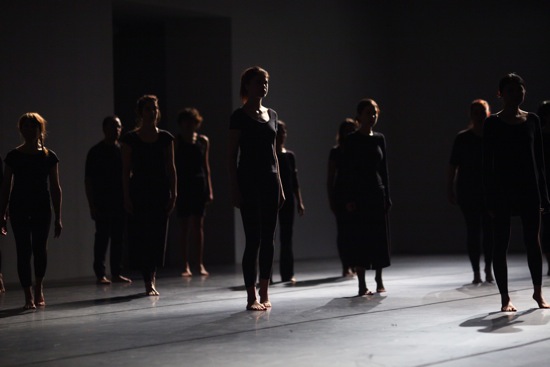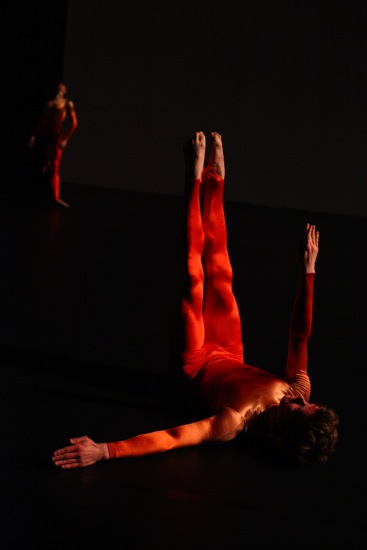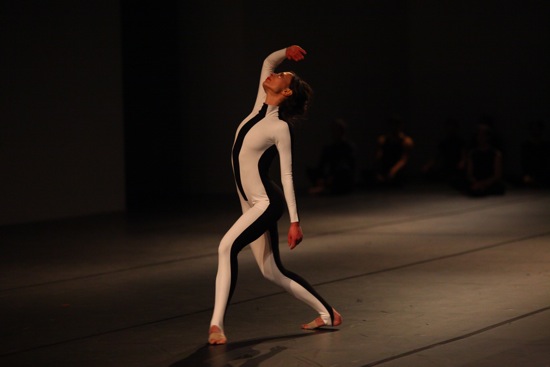“I’m gonna make you howl like a wolf
Scream like a pig
Go through the roof
Lie down with the lion
But to tell you the truth
I’m thinking about starting a zoo.”
So sings Jarvis Cocker, while, Jason Buckle, his mate in the Britpop duo Relaxed Muscle, pounds out a ripe, percussive smear of sound. Is this some red-lit, clinking- glasses club? No, it’s the Olympic-pool-sized, fourth floor gallery of the Whitney Museum of American Art. And partway through British choreographer Michael Clark’s Who’s Zoo?, the two musicians of both Relaxed Muscle and Pulp (Pulp’s recorded songs have already been accompanying the dance) walk into place at one end of the gallery and cut loose. Cocker is garbed as his alter ego, Darren Spooner, which means that his face and hands are painted a greenish brown, and silver makeup traces a skeleton’s skull on his face to match the bony phosphorescent ribs and spine on the tee-shirt he wears under a jacket.
Cocker and Buckle only played live at certain performances of Who’s Zoo?, since, as Pulp, they had other gigs in town. Seeing them in the flesh only reinforces the intriguing connections and disconnections between the visual and aural components of the work. It’s hard to make out the gutty, seedy poetry of the lyrics, with their images of grimy flats, sordid liaisons, elusive love, drugged nights, and desperate bravado, but you get the point.
Clark himself, who hasn’t performed here since 2008, built his reputation in the 1980s. Long of limb, cherubic of face, he punked up his training at the Royal Ballet’s school and his time in Ballet Rambert (when Richard Alston was resident choreographer) to create jousts between impeccable steps and bawdy attire and behavior. He appears intermittently in Who’s Zoo? Skulking about in a dark hoodie, reappearing in shorts instead of long pants, shucking the hoodie for a white tee-shirt, he might be a down-and-out revenant from his days as a reputed bad boy. At the end of the gallery where the musicians hang out, he and the marvelous Julie Cunningham (onetime dancer in Merce Cunningham’s company) play a suggestive game with mirrored stools, swinging them back and forth between their legs. Lion-tamers minus the lions.
So whose zoo is this and who’re you calling a zoo? The rude, plaintive, boastful songs and the hovering, sneaking choreographer seem to belong to a different civilization from that of the dancers, the cool, patterned choreography, and the elegant designs created with light by Charles Atlas (a longtime Clark collaborator). It’s up to us spectators—seated on the floor or standing along one of the gallery’s long sides (stools for the lucky few), turning our heads from side to side to scan the space— to make sense of this culture.
Who’s Zoo? borrows some of the movements and costuming from works that Clark created in London for the Tate Modern’s Turbine Hall. The piece also shares a basic idea with its very well-received British predecessors: highly trained dancers alternate in the space with squads of untrained ones—48 in all (including various of the NYU-Tisch “dance leaders” who worked with them during the weeks when Clark’s open rehearsals became an installation in the Whitney Biennial).
Please don’t feed the animals? The six main performers look as if food isn’t one of their requirements. I don’t just mean that they are exceedingly trim, but that hunger doesn’t figure in the way they dance. They have a faintly inhuman poise, as if they were in the process of turning into another species.
Tall Harry Alexander and Benjamin Warbis enter hand in hand, stepping in precise unison. Shortly, Simon Williams appears, then Oxana Panchenko and Kate Coyne, then Cunningham. They’re clad in identical gleaming high-necked, long-sleeved unitards (by Stevie Stewart and Clark) that shade from burnt orange to golden. Suddenly I find myself remembering what the dancers in Merce Cunningham’s company looked like for a period during late 1970s and 1980s (Clark took a summer course at the Cunningham studio during those years). Most of them—gorgeous though they were—looked slightly stiff, and sober to the point of grimness—as if someone had drilled “the movement is the meaning” into them.
Clark’s very beautiful, very accomplished dancers move with a similar detachment. The choreography calls for quick-footed stepping that shows off pointed feet and straight, probing legs. The performers pirouette, leap; their straight arms wheel or semaphore or thrust up in a V-shape. They seldom move their heads; changing directions, their legs rotate their bodies as single units. It’s this last characteristic in particular that gives them a faintly robotic look. Later they prove that they can arch and bend their spines, angle their elbows to form chicken wings, lift their heads and raise a fist to their brows, twitch their hips to the side, raise and lower their shoulders, and lie in fetal positions. Still, it’s a surprise when Williams first reclines on his side, head on hand, and watches the others for a few seconds.
There’s not a lot of contact between these people, especially in the first section. During a later part, the performers cluster, and there are brief passages of odd, intriguing partnering. The unison, coupled with their demeanor, implies cloning more than camaraderie. I can’t quite grasp how (or if) the words of the songs influenced Clark. Early on, Cunningham places a hand on Alexander’s head (he’s kneeling) then moves on. In “F.E.E.L.I.N.G.C.A.L.L.E.D.L.O.V.E,” the singer says, “And as I touch your shoulder tonight this room has become the centre of the entire universe.” Coincidence? Certainly nothing in the choreography is this redolent of feeling. It’s a a welcome moment when Cunningham, seated on the floor, gazes up, smiling slightly, at the man kiting around her and about to help her rise.
The highly polished dancers are relieved intermittently by the well-rehearsed amateurs. Wearing assorted black clothes, the latter always perform spaced-out in unison squads. They have a simple, effective stepping-turning pattern that, repeated, moves them gradually across the floor. That’s followed by a sequence of single decisive gestures. There are variants of these maneuvers. After each appearance, the people turn and exit with little, bouncy running steps. The precision with which they execute their moves on each heavy percussive beat of the music gives them the air of a peculiar army going through its drills with touching devotion.
The single moment when the “dancers” race through the black-clad ranks is thrilling: an improbable rainbow streaking through a storm. Please let it happen again, you pray. Not a chance.
The sight of dancers coming and going in this huge space provides its own excitement, and Atlas’s light projections work a subtle, enhancing magic. In the beginning a horizontal blue-violet line streaks across the white wall. After a while, it expands to fill the surface, then shrinks down again. A pale green form widens and shifts to create the illusion of angled surfaces; it later “closes” to look like a slim book standing on end, its binding toward us. At one point, a parallelogram of light appears at one end of the wall and as dancers, each in turn, slowly sidle in various ways around the entranceway, the light-shape slides along the wall, morphing and growing as it travels.
For the second part of Who’s Zoo, the performers reappear in unitards that bisect or dissect their bodies with part-black this and part–silver that. Near the end, Clark, brandishing a cane, disappears behind the curtain hiding a large windowed alcove and emerges in a skeleton suit for the group’s bow. Not your usual rebirth. Or your usual ringmaster.
The dancers look as if they should be performing to a spare piece of music like, say, Philip Glass’s Night Train, while the bands and Clark himself suggest a raunchy crowd running amok and getting teary as the night rolls on. Clark has masterminded Who’s Zoo? expertly, but I can’t help wishing that the dancers, the non-dancers, and the music would strike sparks off one another in a formal sense, instead of simply co-existing in eye-filling, ear-assailing ways.




You mentioned the “slightly stiff” look of the Merce Cunningham dancers. It wasn’t my imagination then. If one looked for it, though, it became elusive – except in photographs. Was the origin Merce Cunningham’s own torso, the length of which he sometimes tried to hide in his dancing days but at other times flaunted? Among his dancers an echo of that rigor seemed to persist even after he was no longer a model, until the company’s end.